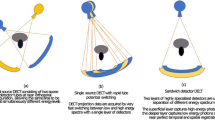Abstract.
The current dominant role of conventional radiography must be reassessed at increasingly shorter intervals in view of the continuing emergence of new imaging modalities that are available to diagnose peripheral musculoskeletal injuries. In comparison with conventional radiography, digital radiographic techniques offer advantages for optimization of image quality and dose, such as a wider dynamic range and post-processing of images. Currently, digital luminescence radiography (storage phosphor radiography) is the most commonly used digital method for obtaining radiographs, using the established positioning projections and routines of the film-screen technique. A new process, radiography with flat-panel amorphous silicon detectors, is still under development. Computed tomography is a valuable tool for diagnosing injuries of the peripheral musculoskeletal system, especially when three-dimensional data sets are acquired; these allow reformating images in all planes desired (2D technique) or in a volumetric format (3D technique). Established indications for CT in the peripheral skeleton are hip fractures, wrist injuries and calcaneal fractures; however, CT may be used as a supplement to radiography in every region of the body. Sonography is beginning to play an increasingly important role in trauma. Muscle and tendon injuries are the most common indications, but worthwhile information can be gained of the shoulder, elbow, hip, and knee joints, supplementing conventional or digital radiography. Magnetic resonance imaging effectively visualizes traumatic changes of the skeleton and the peripheral soft tissues. It is the method of choice to detect occult fractures. It can be used to diagnose muscle and tendon injuries. Joint injuries, especially in the knee and the shoulder joint, are common indications for MRI in the posttraumatic setting.
Similar content being viewed by others
Author information
Authors and Affiliations
Additional information
Electronic Publication
Rights and permissions
About this article
Cite this article
Bohndorf, K., Kilcoyne, R. Traumatic injuries: imaging of peripheral musculoskeletal injuries. Eur Radiol 12, 1605–1616 (2002). https://doi.org/10.1007/s00330-002-1461-8
Published:
Issue Date:
DOI: https://doi.org/10.1007/s00330-002-1461-8




